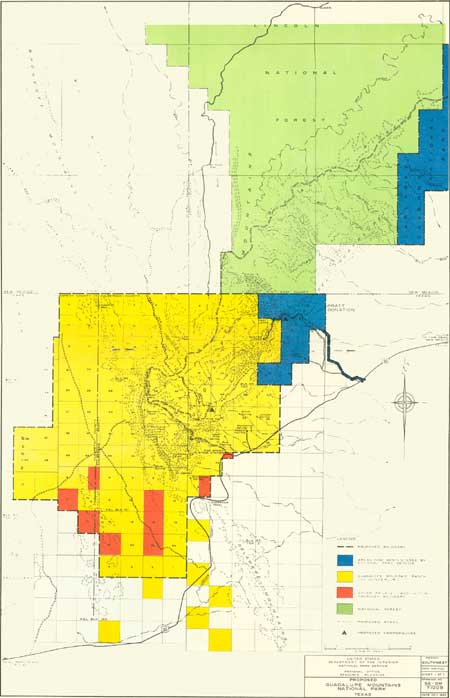|
GUADALUPE MOUNTAINS
Area Investigation Report on a Proposed Guadalupe Mountainsa National Park Texas |

|
INTRODUCTION
The Guadalupe Mountains form the southern terminus of the exposed part of the Capitan Reef, a highland area that rises from an elevation of 3,100 feet, in the Pecos Valley near Carlsbad, New Mexico, to 8,751 feet in Texas, 60 miles to the southwest. At the south end of the Guadalupes, 4,000 feet of Permian rocks are magnificently exposed. The headland, El Capitan, with its sheer, thousand-foot cliff, is visible for 50 miles or more. The Guadalupes separate the Salt Basin on the west from the Delaware Basin on the east. They are an eastward-tilted block uplift of asymmetrical structure, with a complex zone of high-angle faults along the west side. Deep canyons, incised in the highland by running water, contain a unique assemblage of plants and animals that is, at least in part, a relict association of the Pleistocene epoch.
In October 1938, a report entitled Some Geological Observations on the Guadalupe Mountains was submitted by Junior Geologist Ross Maxwell, and a companion report prepared for the Texas State Parks Board entitled Narrative Report on McKittrick Canyon was submitted by Assistant Landscape Architect Obert. The first report summarized the general geology of the area, and the second commended the area to the State for the finest state park in Texas. In 1945 a National Park Service study suggested state ownership for park purposes of the McKittrick Canyon-Guadalupe Peak section of the Guadalupe Mountains of Texas. The report also concluded that the Federal Government should accept the area should it be offered.

|
| Proposed Guadalupe Mountains National Park, Texas. (click on image for an enlargement in a new window) |
The Guadalupe Mountains have been the subject of considerable study, resulting in the following reports:
"Geology of the Southern Guadalupe Mountains, Texas," by Philip E. King, Geological Survey Professional Paper 215, 1948.
Mammals of the Guadalupe Mountains of Western Texas, by William B. Davis, Louisiana State University Press, 1940.
Birds of the Guadalupe Mountain Region of Western Texas, by Thomas D. Burleigh and George H. Lowery, Jr., Louisiana State University Press, 1940.
The Permian Reef Complex of the Guadalupe Mountain Region, Texas and New Mexico, by Newell, Rigby, Fisher, Whiteman, Hickox, and Bradley, W. H. Freeman and Co., 1953.
"Caves along the Slopes of the Guadalupe Mountains," by Edgar B. Howard, Bulletin of the Texas Archeological and Paleontological Society, Vol. IV, September 1932.
An Excavation of Hermit's Cave, New Mexico, by Edwin N. Ferdon, Jr., University of New Mexico Press, 1946.
"Archeological Research in the Guadalupe Mountains," by Edgar B. Howard, The Museum Journal, Vol. XXI, Numbers 3 and 4, The University Museum, University of Pennsylvania, 1930.
Numerous periodical accounts of the Guadalupes have been noted; one of them in the Dearborn Independent, dating back to June 1925, proposes National Park status. The Texas Parade of August 1940 tells of exploration in McKittrick Canyon and hints at state park status for the area, while a September 1959 issue of the same magazine reports on the Pratt donation of North McKittrick to the National Park Service. Several issues of Texas Game and Fish contain articles on the elk, deer, and turkey populations of the Guadalupe Mountains. Papers with subjects more centered on Carlsbad Caverns, but applicable to the Guadalupes as well, have been prepared by, or in conjunction with, the personnel at Carlsbad. These are as follows:
Amphibians and Reptiles of Carlsbad Caverns National Park, New Mexico, by Frederick R. Gehlbach and the Park Interpretive Staff, 1959.
Summary of Zoological Field Investigations Made by Frederick R. Gehlbach at Carlsbad Caverns National Park in 1959 and 1960.
Mammals of Carlsbad Caverns National Park, New Mexico, by Park Staff, 1960.
A Checklist of the Birds of Carlsbad Caverns National Park, Park Publication, 1960.
The present report is based upon field investigations made by the Regional Director of the Southwest Region and by staff members of the regional office and of Carlsbad Caverns National Park. There were three main investigations, in April 1958, May 1961, and June 1963 Most of the geologic material was provided by Mr. Bennett T. Gale, of the Western Regional Office, and most of the material on botany, animal life, archeology, and history was provided by Park Naturalist Paul Spangle.
Of the many attributes that contribute to the significance of the area, the geology must be given highest priority. Although Carlsbad Caverns National Park and North McKittrick Canyon contain prime examples of the Capitan Reef and Permian Basin geology, the scenic and spectacular southern end of the Guadalupe Mountain Range further complements this superb display by providing exposures of back-reef and fore-reef beds not found elsewhere, as well as showing the most dramatic cross-section of the fossil reef. Add to the geology the unique ecological assemblage in both branches of McKittrick Canyon, as well as the highest and possibly the ruggedest, most scenic portions of Texas, and the park and recreation potential of the area is evident.
| <<< Previous | <<< Contents>>> | Next >>> |
gumo/report/intro.htm
Last Updated: 09-Feb-2007